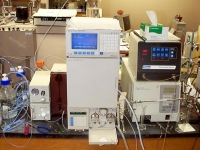We have recently developed capabilities to measure high temperature/high pressure properties of surfactants. We have built a special cell which is capable of measuring interfacial tensions of oil-water mixtures above the normal boiling point of water. We also can measure adsorption of surfactants under these conditions as well.
In the study of micelle formation, CMC measurements by surface tensions and conductivity are done routinely. Calorimetry is being used to measure the heats of formation of micelles, heats of formation of admicelles, and the heat of mixing in the formation of mixed micelles or admicelles. Counterion binding is measured using specific ion electrodes, while aggregation numbers can be determined using small-angle x-ray scattering or, if more detailed information is required, our group has experience with neutron scattering at national laboratories. Other methods useful in the study of these phenomena are NMR and density.
We can measure the solubilization of organics by micelles with the greatest accuracy now available. For volatile compounds, a vapor pressure method is employed. For less volatile compounds, a newly developed technique from our laboratory, semi-equilibrium dialysis, is used. Headspace chromatography or micellar-enhanced ultrafiltration are also useful tools for this type of measurement.
Our laboratory can also measure adsorption isotherms for adsorption of surfactants on a variety of solids using HPLC. The co-adsorption or adsolubilization of other constituents can also be measured. Counterion binding on admicelles can be calculated from measured electrophoretic mobilities and zeta potentials can be measured. Column systems are used to study the chromatographic separation of surfactant and other components. Ellipsometry and quartz crystal microbalance measurements are used to characterize adsorbed layers on a flat surface.
We have the capability of measuring properties of a number of other aggregates formed by surfactants. Differential scanning calorimetry is useful in the study of phase transitions in mesomorphic systems. We have developed a variety of methods for determining the phase boundary in precipitating systems, utilizing laser light scattering, spectroscopy, specific ion electrodes, visual methods, and surface tension. The composition and characteristics of coacervate formed above the cloud point of solutions, and microemulsions formed in oil/water systems can also be studied using our instrumentation.

